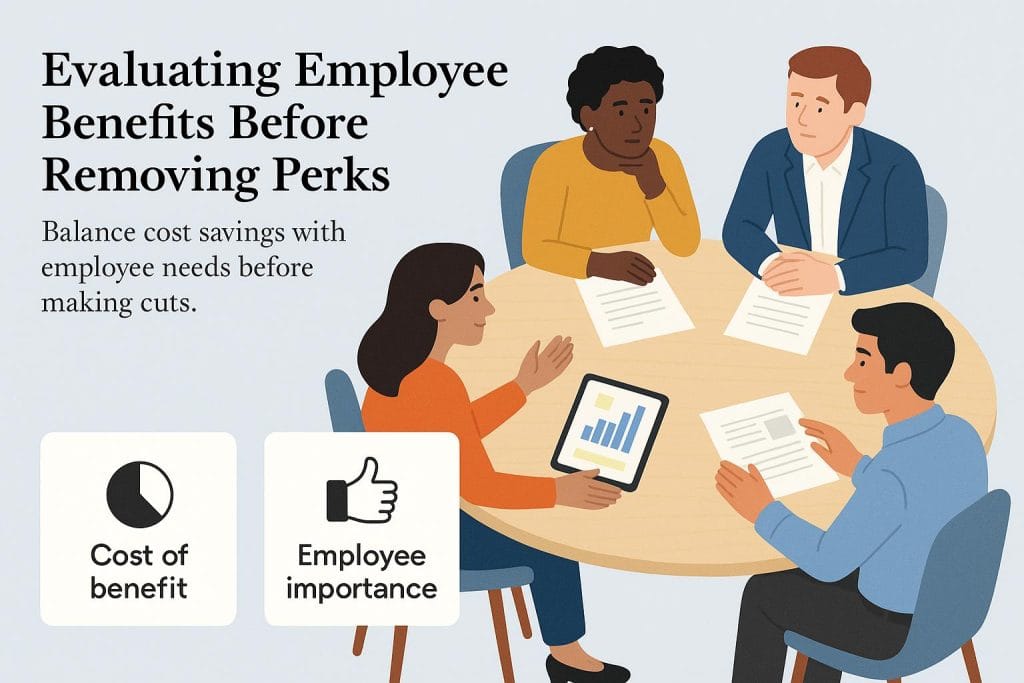Business.com aims to help business owners make informed decisions to support and grow their companies. We research and recommend products and services suitable for various business types, investing thousands of hours each year in this process.
As a business, we need to generate revenue to sustain our content. We have financial relationships with some companies we cover, earning commissions when readers purchase from our partners or share information about their needs. These relationships do not dictate our advice and recommendations. Our editorial team independently evaluates and recommends products and services based on their research and expertise. Learn more about our process and partners here.
How to Take Away Perks Without Employees Hating You
If you have to eliminate some employee benefits, here are seven steps you can follow to help prevent a staff rebellion.

Table of Contents
Times are tough. Companies are laying off workers, and the U.S. unemployment rate reached 4.3 percent in August 2025. With costs rising and growth slowing, employers are making tough calls, including whether to scale back employee benefits. In fact, according to the WTW Benefits Trends Survey 2025, 90 percent of U.S. employers say rising benefit costs are shaping their strategies, with 63 percent planning to reallocate or rebalance their benefit spend.
Now, we know what you’re thinking: Trimming perks might spark a staff mutiny. That’s why we spoke with industry experts about how to cut costs strategically while still keeping employees happy and engaged — or at least preventing a full-on revolt.
How to take away employee perks and benefits

If you’ve decided to scale back benefits to cut company expenses, you’ll want to do it carefully. These seven steps can help minimize resistance and keep morale intact.
1. Decide which benefits make sense to cut.
No one enjoys eliminating employee perks, but sometimes it’s unavoidable. Start by weighing the cost and value of each benefit. You can make the call yourself as the business owner, or you can pull together a small group of key leaders — like your CFO, HR head and benefits adviser — to get a fuller picture of the impact.
Think beyond the dollar signs. Ask which perks employees actually use and which ones they’d miss most. For example, a young workforce might care more about losing tuition reimbursement than child care assistance. And some essentials, like health insurance, should never be on the chopping block.
2. Talk to your managers first.
Getting managers on board with your plans can help ease employee concerns during the transition. Have an open and honest conversation with supervisors and team leaders and address any questions they may have. Since managers are your eyes on the ground, preparing them ahead of time will make the next step — talking to employees — much smoother.
3. Be transparent with employees ASAP.
When it’s time to tell employees the hard truth that a benefit is being cut, transparency is a must. Being vague will only frustrate your team, and putting off the conversation will make things worse.
Jared Pope, founder and CEO of Work Shield, has more than 20 years of experience protecting and cultivating workplace culture. He says honest communication is key to minimizing fallout when removing employee benefits.
“Most employees are willing to accept change if the employer is transparent,” Pope explained. “Also, if benefits are changing that could impact employees’ budgets, the more advance notice the organization can provide, the better.”
The Society for Human Resource Management (SHRM) makes a similar point in its communication guidelines: Benefit communication should be clear, inclusive and accessible to everyone. When employees understand what’s changing and why, they can make more informed decisions.
These conversations may still be uncomfortable, but it’s worth having them directly. Meet with employees in groups and offer one-on-one discussions for anyone who wants more detail. Some staff members will be upset, but explaining openly and early will make the news easier to process.
4. Lead with empathy.
Along with business transparency, approach benefit-reduction conversations with empathy. No one likes to hear bad news, but delivering it in a way that helps employees feel valued and understood can make a big difference. Show compassion for how the change will affect them.
“Despite our best efforts, sharing news of cutting back benefits can be difficult, and we cannot control the feelings of those who are impacted,” said Carolyn Clark, VP of employee experience strategy at Simpplr. “However, we can do our best to deliver the message with warmth, transparency and effectiveness.”
5. Explain the “what, why, how.”
Explain exactly what’s changing (e.g., which benefit is ending and who’s affected), why it’s changing (e.g., to reduce overhead costs and avoid layoffs) and how it will work (timeline and mechanics). Keep it concrete and put the details in writing (FAQ or memo) so employees can reference them.
Cover the essentials (as applicable):
- Timeline: Share the last effective date and any grace or runout periods.
- Eligibility and scope: Explain who’s affected and any proration rules.
- Money matters: Note details such as reimbursements in progress, final pay impacts and PTO balances.
- Plan specifics: Detail vesting or match impacts, portability and conversion options for life or disability insurance, and FSA or HSA claims runout.
- Support: Tell employees whom they can contact with questions and where to find the FAQs.
Clark suggests going over the steps you tried before making this decision (e.g., shrinking office space or leadership pay cuts) and the alternatives you’re avoiding.”Share what the alternative was if the benefit was not cut,” Clark advised. “This could be cutting salaries or reducing headcount. This is crucial to bringing understanding to the situation.”
6. Offer alternative benefits, if possible.
You might be thinking, “If I have to cut some of my team’s current benefits, why would I add more?” Here’s why: Sometimes costly perks aren’t sustainable anymore, but you can replace them with other options that employees still value and that cost far less.
Some no- or low-cost benefits employees often appreciate include:
- Flexible scheduling or remote work plans
- Additional paid leave
- Professional development opportunities like lunch-and-learns or online training subscriptions
- Employee recognition programs, including peer-to-peer recognition platforms
- Wellness initiatives such as walking challenges or mental health apps
- Team building activities like monthly lunches or quarterly outings
“[Adding less-costly benefits] lessens the fear of scarcity and helps the employee to know that the employer is trying to compensate in other ways,” Pope explained. “The goal is to be authentic and open about the decision.”
If you’re unsure which additional perks would resonate, ask your employees directly. A quick survey can show you what they’d value most and help you shape an employee benefits package that balances cost, compliance and employee needs.
7. Recognize and support employees.
Your responsibility to your employees in this situation doesn’t end as soon as you have “the talk.” Your team will likely experience some unease and disappointment during the transition, and that’s OK. It’s crucial that your leadership team stays visible and supportive, whether through town halls, team meetings or casual coffee chats.
It’s especially important that you remind employees just how important and valuable they are to the organization and that cutting back on benefits is not a reflection of their performance. Whether employees work remotely or in the office, Clark advises creating chances for team members to feel seen and heard whenever possible.
“[Provide employees with] quality time from leaders — whether that’s a short video with updates every week or every other week, hand-written notes or in-person events that provide opportunities for employees to connect,” Clark said.
Measuring the impact of benefit changes
Cutting back on perks doesn’t end with the announcement; it’s just as important to watch how the change affects your team. Before you roll out any reductions, establish a baseline: Run a quick anonymous survey, track metrics like turnover and workplace absenteeism, and document your current employee Net Promoter Score (eNPS). That way, you’ll know if things start to slip.
Once the change goes into effect, keep an eye on the numbers at 30, 60 and 90 days. Short pulse surveys, exit interview notes and productivity data can all tell you how employees are adjusting. For example, you might calculate satisfaction as a percentage score or track voluntary turnover to see if cuts are driving people away.
Why does this matter? Employee sentiment improved in 2025, with BambooHR’s index climbing to 40 — a 12 percent year-over-year increase. That rebound stems largely from appreciation for stability, so monitoring morale during benefit changes is key to preserving it.
Following up and rebuilding trust
Communication shouldn’t stop once the initial conversations are over. A thoughtful follow-up plan can help employees feel supported and keep small frustrations from turning into bigger issues.
- Week 1-2: Check in one-on-one with team leads and key employees. Answer questions and clear up confusion quickly.
- 30-60 days: Send out another pulse survey, hold a town hall if needed, and gauge how alternative benefits are being received.
- 3-6 months: Review survey results, adjust your approach based on employee feedback, and strengthen manager-employee relationships through training or additional support. If the business is doing better, you might even reintroduce a perk you cut.
- Quarterly: Step back and look at the big picture — retention, satisfaction trends and business performance — to guide your long-term benefit strategy.
How to keep employees happy after cutting back
Keeping employees engaged after reducing benefits takes effort, but it’s possible. The fallout will depend on how valuable the cut perks were, yet you can soften the blow with a few key strategies:
- Strengthen relationships: Invest in the employee experience in ways that don’t cost much — like improving manager-employee connections or hosting team-building activities. “As humans, we thrive on connection and relationships,” said Clark. “We fall back on the reserve of strength of relationships when times are tough.”
- Reinforce culture and mission: Employees want to feel connected to each other and your company’s purpose. Remind your team of the bigger mission and vision. As Pope noted, when workers feel part of something larger, they’ll keep bringing passion and energy even if a benefit goes away.
- Recognize employees: Showing employee appreciation matters more than ever during times of change. Go the extra mile to make team members feel seen, whether through public recognition, handwritten notes or simple check-ins. This helps reinforce that the cuts aren’t a reflection of poor performance and that your workplace is still rewarding.
By leaning on relationships, culture and recognition, you can help employees stay motivated and preserve trust in your organization, even when financial realities force tough benefit decisions.




